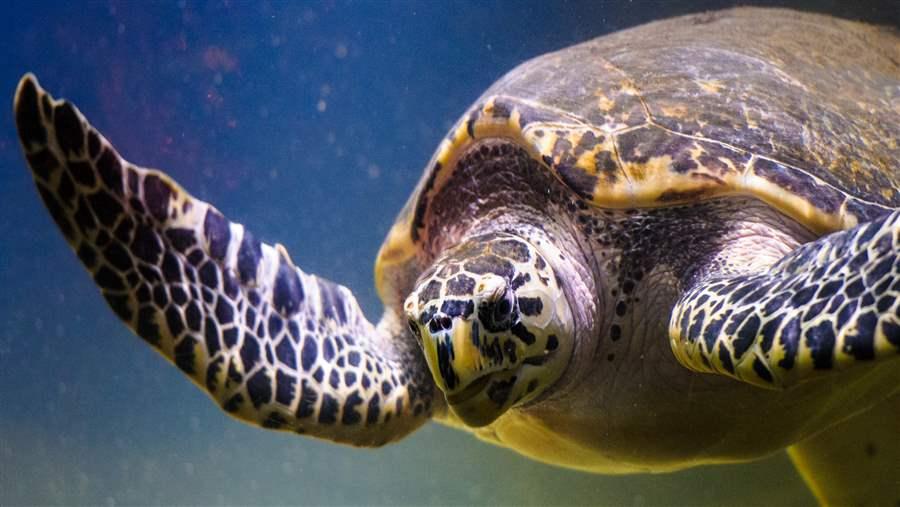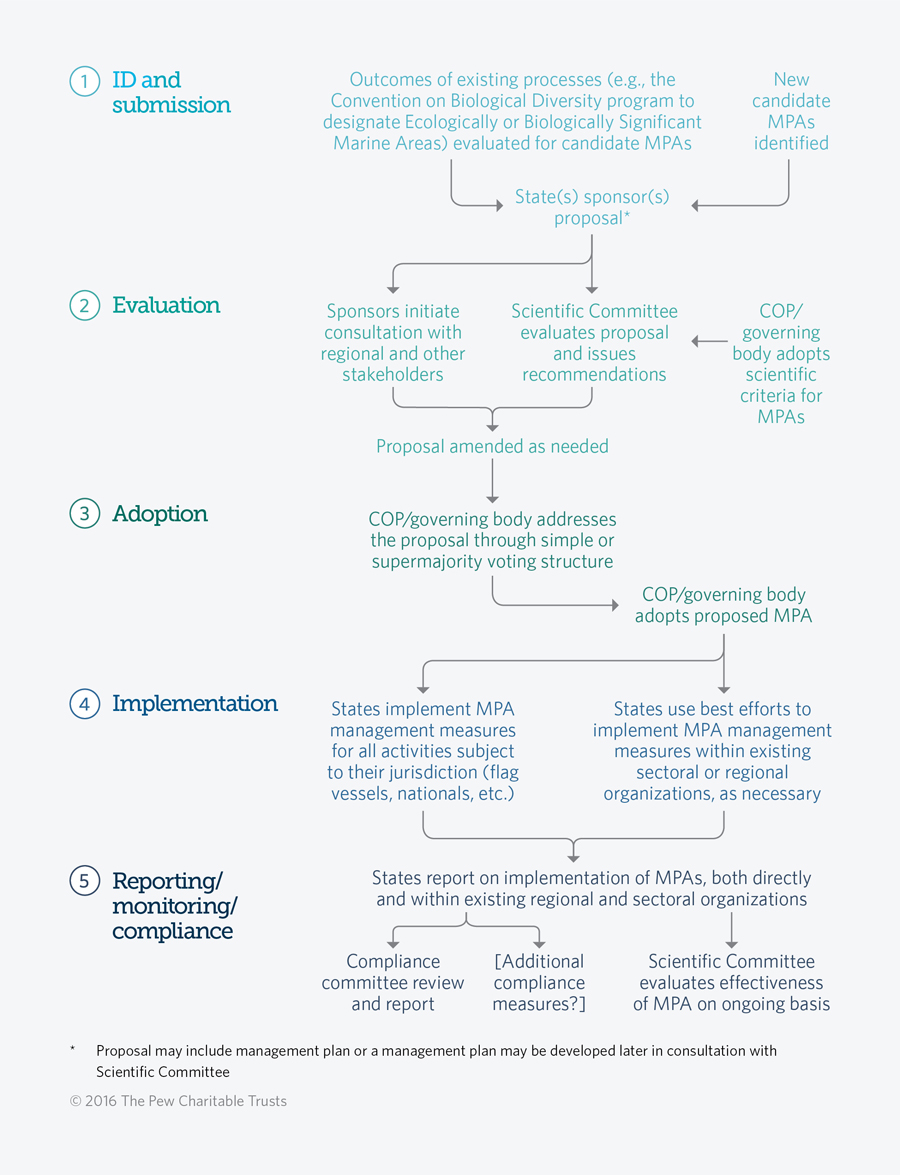Marine Protected Areas Beyond National Jurisdiction
 Shutterstock
ShutterstockHigh seas MPAs and reserves could be highly effective tools for protecting marine biodiversity.
NOTE: This issue brief was updated March 22, 2016, to mention a study that appeared recently in the journal Conservation Letters.
Overview
Although we still know little about the intricate ocean ecosystems far offshore, we do know this: Once thought to be barren marine deserts, the high seas and deep ocean beneath them are teeming with life. Underwater seamounts are home to creatures found nowhere else on Earth, hydrothermal vents cradle some of the oldest organisms on the planet, and critical migration routes help sustain species, which in turn support ecosystems and livelihoods around the world. All of this lies beyond the jurisdiction of any country and beyond the ability of any government to protect this area alone. Marine protected areas (MPAs)—and, in particular, reserves—are among the best tools that can be used to safeguard these treasures.
What are MPAs and why are they important?
The International Union for Conservation of Nature defines any protected area as “a clearly defined geographical space, recognized, dedicated and managed, through legal or other effective means, to achieve the long-term conservation of nature with associated ecosystem services and cultural values.”1 Put simply, an MPA is an area designated to be under special management to help conserve the biological diversity and productivity (including ecological life support systems) of the oceans.”2 In an MPA, some human activity may be allowed; in a reserve, such activity is strictly limited, which helps to maximize conservation benefits.3
Well-designed and well-managed MPAs, especially fully protected reserves, have been shown to safeguard biodiversity,4 provide ecological benefits to neighboring ecosystems,5 and protect predators to help maintain ecosystem stability.6 Such areas can also serve as important climate reference points for scientists, and although establishing an MPA or reserve won’t stop ocean acidification or warming, it can help build ecosystem resilience by eliminating other stresses. These benefits are amplified when MPAs are large, well-managed, isolated and long-lasting.7 MPAs are thus a critical tool for policymakers seeking to pass a healthy marine environment on to future generations.
Governments around the world have recognized the need for and the value of strong marine conservation, including the benefits that MPAs and reserves provide. In 2015, the 193 member States of the United Nations confirmed their commitment to conserve at least 10 percent of coastal and marine areas by 2020, incorporating a target established under the Convention on Biological Diversity into the U.N.’s 2030 Agenda for Sustainable Development.
While that’s a good start, scientists recommend a more ambitious approach to marine conservation. In 2016, a study in the journal Conservation Letters confirmed that 30 percent of the world’s oceans need protection through MPAs or reserves.8 This is consistent with the recommendation agreed upon by participants at the World Parks Congress in November 2014: to urgently increase the area of ocean managed through a network of well-connected MPAs, with the aim of protecting at least 30 percent of each habitat in the ocean and 30 percent of the world’s oceans overall.9
Critical features of a high seas MPA regime
The protection of such large areas of the ocean cannot be achieved without incorporating parts of the high seas into that well-connected MPA network. In spite of the urgent need to protect more of the ocean, States have no mechanisms to create comprehensive, globally recognized MPAs and reserves on the high seas.
Instead, there is a patchwork of bodies, including regional fisheries management organizations, that set policies for specific areas of the ocean or activities (such as fishing for tuna). But those bodies lack the legal mandate necessary to establish MPAs or set and enforce conservation policies that will protect biodiversity throughout an ecosystem.
A new international agreement on high seas biodiversity can address this gap by providing the following:
- A mechanism to identify and designate potential high seas MPAs: A framework through which States can propose and agree on the designation of high seas MPAs would provide a path toward establishing such MPAs.
- Science-based criteria for evaluating potential MPAs: The establishment of high seas MPAs should be based on environmental considerations, strongly guided by scientific standards. Models for such criteria include those adopted through the Convention on Biological Diversity’s process to identify Ecologically or Biologically Significant Marine Areas. A committee of scientific experts should use such criteria to help evaluate proposals for new protected areas.
- A framework for adopting meaningful conservation objectives and enforceable management plans: Leaving MPA implementation to existing sectoral bodies would be ineffective because most of those bodies lack a mandate to protect biodiversity generally. High seas MPAs created with concrete objectives, management plans and enforcement protocols are more likely to become real tools for biodiversity protection than are so-called “paper parks” established without such parameters.
- A means of consulting and collaborating with existing sectoral and regional organizations: Under the new instrument, parties should be able to formally consult with existing sectoral bodies and similar organizations. These consultations would help to avoid conflict between management measures adopted under the new instrument and pre-existing obligations to those organizations. States can also use their best efforts to encourage organizations to adopt complementary measures recognizing high seas MPAs but should not allow these efforts to delay establishment or implementation of the MPAs. For example, the International Maritime Organization could recognize a new MPA as a Particularly Sensitive Sea Area, thus alerting all IMO members that the area is protected.
Sample Process for Creating an MPA in ABNJ

Key characteristics of a successful MPA framework
Based on lessons learned from coastal zones, to ensure a successful system of MPAs on the high seas, a framework should at least provide for:
- Regional stakeholder consultation, where appropriate: While the high seas do not belong to any one country, organization or business, some parts are of particular concern to certain regional stakeholders. States considering creation of an MPA should consult with those stakeholders. Such coordination can help secure the support of the groups most likely to be affected by creation of the protected area. By the same token, a proposal submitted with the support of a uniquely concerned region should be prioritized by all other parties to the instrument.
- Ongoing monitoring and enforcement: The first line of monitoring and enforcement of high seas MPAs should come from States; they have the authority to take action if, for example, one of their flagged vessels violates the provisions of a protected area. Emerging technologies, such as satellite monitoring of activity on the oceans, may help in this effort. Parties that have adopted the instrument could, therefore, report regularly to each other on their implementation efforts. Under other international agreements, committees have been appointed to evaluate compliance reporting in similar contexts and might be useful under a new instrument as well.
Conclusion
High seas MPAs and reserves could be highly effective tools for protecting marine biodiversity and helping governments meet their commitments to safeguard more of our oceans. In working toward a treaty to protect high seas biodiversity, the U.N. should include the elements described above, which will help make effective, enforceable high seas MPAs and reserves a reality.
Endnotes
- Jon Day et al., “Guidelines for Applying the IUCN Protected Area Management Categories to Marine Protected Areas,” Best Practice Protected Area Guidelines Series No. 19 (2012), https://cmsdata.iucn.org/downloads/iucn_categoriesmpa_eng.pdf.
- Ibid.
- Ibid.
- Sarah E. Lester et al., “Biological Effects Within No-Take Marine Reserves: A Global Synthesis,” Marine Ecology Progress Series 384 (2009):
33–46, doi:10.3354/meps08029. - Rene A. Abesamis and Garry R. Russ, “Density-Dependent Spillover From a Marine Reserve: Long-Term Evidence,” Ecological Applications 15, no. 5 (2005): 1798–1812, http://onlinelibrary.wiley.com/doi/10.1890/05-0174/abstract; Hugo B. Harrison et al., “Larval Export From Marine Reserves and the Recruitment Benefit for Fish and Fisheries,” Current Biology 22, no. 11 (2012): R444–46, doi:10.1016/j.cub.2012.04.008.
- Garry R. Russ and Angel C. Alcala, “Marine Reserves: Long-Term Protection Is Required for Full Recovery of Predatory Fish Populations,” Oecologia 138, no. 4 (2004): 622–27, doi:10.1007/s00442-003-1456-4; Gregory L. Britten et al., “Predator Decline Leads to Decreased Stability in a Coastal Fish Community,” Ecology Letters 17, no. 12 (2014): 1518–25, doi:10.1111/ele.12354; Jordi Bascompte, Carlos Melian and Enric Sala, “Interaction Strength Combinations and the Overfishing of a Marine Food Web,” Proceedings of the National Academy of Sciences 102, no. 15 (2005): 5443–47, doi:10.1073/pnas.0501562102.
- Graham J. Edgar et al., “Global Conservation Outcomes Depend on Marine Protected Areas With Five Key Features,” Nature 506, no. 7487 (2014): 216–20, doi:10.1038/nature13022.
- Bethan O’Leary et al., “Effective Coverage Targets for Ocean Protection,” Conservation Letters, doi: 10.111/conl.12247
- Recommendations of the Marine Cross-Cutting Theme at the 6th IUCN World Parks Congress in Sydney, Australia (Nov. 12–19, 2014), http://worldparkscongress.org/downloads/approaches/ThemeM.pdf.






